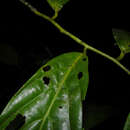en
names in breadcrumbs


Cremastosperma is a genus of flowering plants in the family Annonaceae, subfamily Malmeoideae, tribe Malmeae.[1] In 2018 there were 34 recognised species distributed in Central and South America.[2]
Cremastosperma was described by Robert Elias Fries in 1930,[3] based on Aberemoa pedunculata Diels, originally described by Ludwig Diels (1906),[4] which thus became the type species Cremastosperma pedunculatum (Diels) R.E.Fr..
Species of Cremastosperma are found in lowland to pre-montane tropical forest in the Neotropics.[5] The greatest species diversity is distributed in the narrow tropical zone to the west of the Andean mountain chain on the Pacific Ocean side of north-western South America, north into Central America[6] as far as Costa Rica;[2] and on the eastern side of the Andes extending from Colombia through eastern Ecuador and Peru as far south as Bolivia. Two species are found in coastal Venezuela (Cremastosperma macrocarpum Maas and Cremastosperma venezuelanum Pirie),[7] and one in French Guiana (Cremastosperma brevipes (DC.) R.E.Fr.).
Cremastosperma species are small understory trees with typical Annonaceae floral morphology (sepals and petals in whorls of three; indefinite numbers of spirally arranged stamens and carpels) bearing a resemblance to various other Neotropical genera with apocarpous, single-seeded, stipitate fruits (such as Guatteria). The most useful character by which they can be distinguished from these and other similar Neotropical Annonaceae is displayed by the midrib of the leaves, which is raised on the upper side with an unusual, mostly conspicuous, longitudinal groove.
Recognised species:
Cremastosperma is a genus of flowering plants in the family Annonaceae, subfamily Malmeoideae, tribe Malmeae. In 2018 there were 34 recognised species distributed in Central and South America.
Cremastosperma was described by Robert Elias Fries in 1930, based on Aberemoa pedunculata Diels, originally described by Ludwig Diels (1906), which thus became the type species Cremastosperma pedunculatum (Diels) R.E.Fr..
Species of Cremastosperma are found in lowland to pre-montane tropical forest in the Neotropics. The greatest species diversity is distributed in the narrow tropical zone to the west of the Andean mountain chain on the Pacific Ocean side of north-western South America, north into Central America as far as Costa Rica; and on the eastern side of the Andes extending from Colombia through eastern Ecuador and Peru as far south as Bolivia. Two species are found in coastal Venezuela (Cremastosperma macrocarpum Maas and Cremastosperma venezuelanum Pirie), and one in French Guiana (Cremastosperma brevipes (DC.) R.E.Fr.).
Cremastosperma es un género de plantas fanerógamas con 34 especies[1] perteneciente a la familia de las anonáceas. Son nativas de América meridional.[2]
Son arbustos o árboles con 1, rara vez 2, flores axilares, o a veces caulifloras. Flores medianas, generalmente glabras; pedicelos articulados sobre la base, casi siempre con una pequeña bráctea por encima de la articulación. Sépalos libres, imbricados en la yema, con márgenes, ciliolados delgados. Pétalos mucho más largos que el cáliz, rígidos, imbricados, con bordes delgados. Estambres numerosos, el conectivo expandido por encima de la antera en un disco. Carpelos varios; óvulo 1, que se adjunta cerca del extremo superior del ovario y pendular, o, a veces se encuentra más abajo, incluso cerca de la base y, a continuación erecto. Monocarpo libre.[3]
El género fue descrito por Robert Elias Fries y publicado en Acta Horti Bergiani 10: 46. 1931.[3] La especie tipo es: Cremastosperma pedunculatum (Diels) R.E. Fr.
Cremastosperma es un género de plantas fanerógamas con 34 especies perteneciente a la familia de las anonáceas. Son nativas de América meridional.
Cremastosperma R.E.Fr. – rodzaj roślin z rodziny flaszowcowatych (Annonaceae Juss.). Według The Plant List w obrębie tego rodzaju znajdują się 31 gatunki o nazwach zweryfikowanych i zaakceptowanych, podczas gdy kolejne 4 taksony mają status gatunków niepewnych (niezweryfikowanych)[3]. Występuje naturalnie w klimacie równikowym Ameryki Południowej[4]. Gatunkiem typowym jest C. pedunculatum (Diels) R.E.Fr.[2]
Rodzaj wraz z całą rodziną flaszowcowatych w ramach rzędu magnoliowców wchodzi w skład jednej ze starszych linii rozwojowych okrytonasiennych określanych jako klad magnoliowych[1].
Cremastosperma R.E.Fr. – rodzaj roślin z rodziny flaszowcowatych (Annonaceae Juss.). Według The Plant List w obrębie tego rodzaju znajdują się 31 gatunki o nazwach zweryfikowanych i zaakceptowanych, podczas gdy kolejne 4 taksony mają status gatunków niepewnych (niezweryfikowanych). Występuje naturalnie w klimacie równikowym Ameryki Południowej. Gatunkiem typowym jest C. pedunculatum (Diels) R.E.Fr.
Cremastosperma é um género botânico pertencente à família Annonaceae[1].
Cremastosperma é um género botânico pertencente à família Annonaceae.
«Cremastosperma — World Flora Online». www.worldfloraonline.org. Consultado em 19 de agosto de 2020Cremastosperma[1] este un gen de plante angiosperme din familia Annonaceae.[1]
Cladograma conform Catalogue of Life[1]:
Cremastosperma là chi thực vật có hoa trong họ Annonaceae.[1]
Cremastosperma là chi thực vật có hoa trong họ Annonaceae.